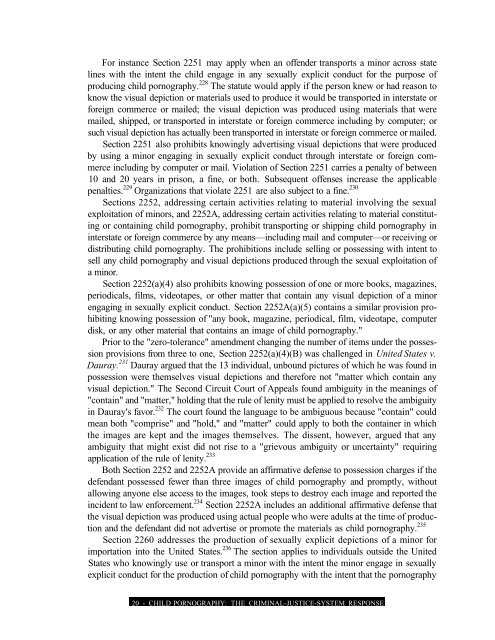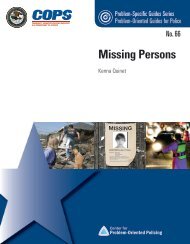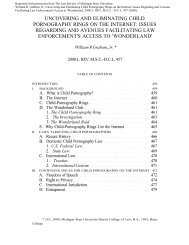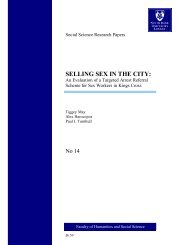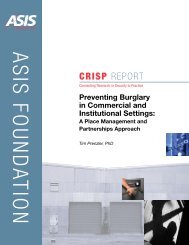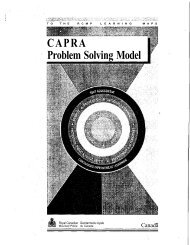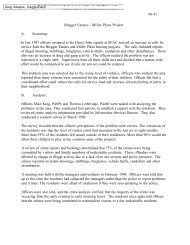Child Pornography: - Center for Problem-Oriented Policing
Child Pornography: - Center for Problem-Oriented Policing
Child Pornography: - Center for Problem-Oriented Policing
You also want an ePaper? Increase the reach of your titles
YUMPU automatically turns print PDFs into web optimized ePapers that Google loves.
For instance Section 2251 may apply when an offender transports a minor across state<br />
lines with the intent the child engage in any sexually explicit conduct <strong>for</strong> the purpose of<br />
producing child pornography. 228 The statute would apply if the person knew or had reason to<br />
know the visual depiction or materials used to produce it would be transported in interstate or<br />
<strong>for</strong>eign commerce or mailed; the visual depiction was produced using materials that were<br />
mailed, shipped, or transported in interstate or <strong>for</strong>eign commerce including by computer; or<br />
such visual depiction has actually been transported in interstate or <strong>for</strong>eign commerce or mailed.<br />
Section 2251 also prohibits knowingly advertising visual depictions that were produced<br />
by using a minor engaging in sexually explicit conduct through interstate or <strong>for</strong>eign commerce<br />
including by computer or mail. Violation of Section 2251 carries a penalty of between<br />
10 and 20 years in prison, a fine, or both. Subsequent offenses increase the applicable<br />
penalties. 229 Organizations that violate 2251 are also subject to a fine. 230<br />
Sections 2252, addressing certain activities relating to material involving the sexual<br />
exploitation of minors, and 2252A, addressing certain activities relating to material constituting<br />
or containing child pornography, prohibit transporting or shipping child pornography in<br />
interstate or <strong>for</strong>eign commerce by any means—including mail and computer—or receiving or<br />
distributing child pornography. The prohibitions include selling or possessing with intent to<br />
sell any child pornography and visual depictions produced through the sexual exploitation of<br />
a minor.<br />
Section 2252(a)(4) also prohibits knowing possession of one or more books, magazines,<br />
periodicals, films, videotapes, or other matter that contain any visual depiction of a minor<br />
engaging in sexually explicit conduct. Section 2252A(a)(5) contains a similar provision prohibiting<br />
knowing possession of "any book, magazine, periodical, film, videotape, computer<br />
disk, or any other material that contains an image of child pornography."<br />
Prior to the "zero-tolerance" amendment changing the number of items under the possession<br />
provisions from three to one, Section 2252(a)(4)(B) was challenged in United States v.<br />
Dauray. 231 Dauray argued that the 13 individual, unbound pictures of which he was found in<br />
possession were themselves visual depictions and there<strong>for</strong>e not "matter which contain any<br />
visual depiction." The Second Circuit Court of Appeals found ambiguity in the meanings of<br />
"contain" and "matter," holding that the rule of lenity must be applied to resolve the ambiguity<br />
in Dauray's favor. 232 The court found the language to be ambiguous because "contain" could<br />
mean both "comprise" and "hold," and "matter" could apply to both the container in which<br />
the images are kept and the images themselves. The dissent, however, argued that any<br />
ambiguity that might exist did not rise to a "grievous ambiguity or uncertainty" requiring<br />
application of the rule of lenity. 233<br />
Both Section 2252 and 2252A provide an affirmative defense to possession charges if the<br />
defendant possessed fewer than three images of child pornography and promptly, without<br />
allowing anyone else access to the images, took steps to destroy each image and reported the<br />
incident to law en<strong>for</strong>cement. 234 Section 2252A includes an additional affirmative defense that<br />
the visual depiction was produced using actual people who were adults at the time of production<br />
and the defendant did not advertise or promote the materials as child pornography. 235<br />
Section 2260 addresses the production of sexually explicit depictions of a minor <strong>for</strong><br />
importation into the United States. 236 The section applies to individuals outside the United<br />
States who knowingly use or transport a minor with the intent the minor engage in sexually<br />
explicit conduct <strong>for</strong> the production of child pornography with the intent that the pornography<br />
20 - CHILD PORNOGRAPHY: THE CRIMINAL-JUSTICE-SYSTEM RESPONSE


